Crypto’s 69 most interesting charts from 2021

As most of us were enjoying some R&R over Christmas break, Coinbase Cloud protocol specialist Elias Simos was scouring the web for the most interesting crypto charts of 2021: 69 of them to be exact.
In the latest Around The Block podcast, we sit down with Elias and discuss some of the most interesting data points from the year, and what it all means for the future. (High level takeaways below)
Metaverse and smart contract assets outperform
Price isn’t everything, but the two top performing assets in 2021 are indicative of broader trends throughout the year. 2021’s best performing assets were:
- Metaverse gaming tokens
- Smart contract platform tokens
The governance tokens of gaming worlds Axie Infinity (AXS) and The Sandbox (SAND) each posted 16,000 and 13,000 percent gains respectively. Meanwhile, platform tokens from Polygon, Terra, Solana, and Fantom, all posted 8,000% gains or more.
Given that play-to-earn gaming had a breakout year, and layer 1s not named Ethereum saw strong adoption, these trends should be of no surprise. Now let’s dig a bit deeper.
The state of Layer 1s
Ethereum’s native token (ETH) did a modest 2X over the year, while it was somewhat of a rough year for Ethereum DeFi blue chips, with the DeFiPulse index down 80% over the year vs ETH.
The price of DeFi assets doesn’t tell the entire story, however. TVL of Ethereum DeFi applications showed tremendous growth over the year, and the number of unique Ethereum addresses interacting with DeFi protocols 4x’ed.
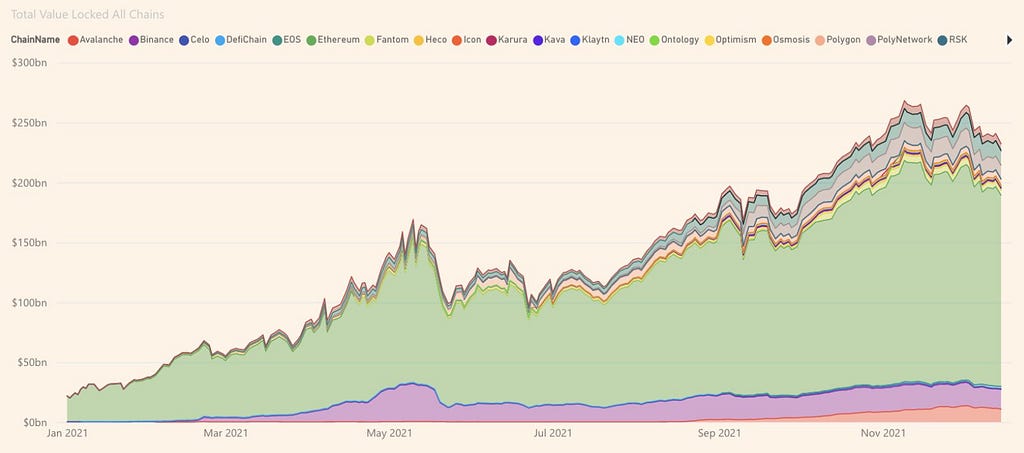
Regardless, ETH killers and sidechains won the year when measured by growth of overall market share.
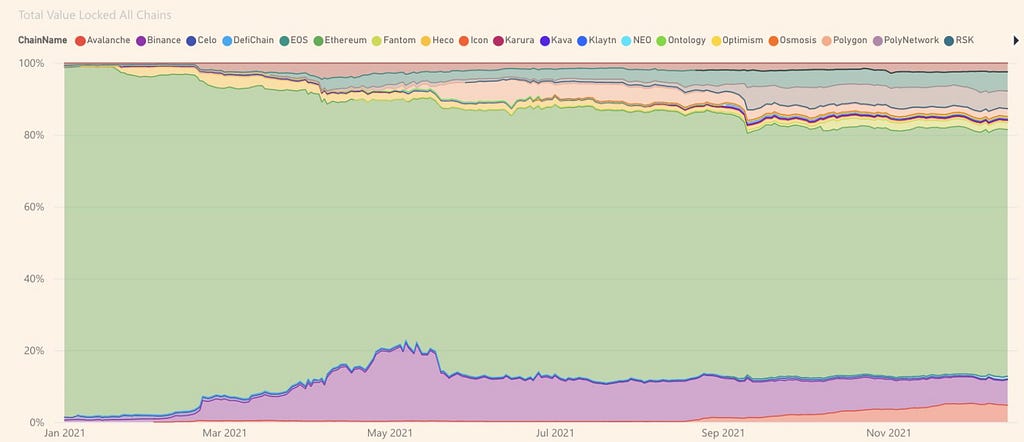
The great migration & the EVM standard
In May, there was $200M sitting in Ethereum bridges. That number climbed to $20B by the end of the year, underscoring the great migration of value from Ethereum to other ecosystems.
The flipside, however, is that despite this migration away from Ethereum, most value still sits in EVM (Ethereum Virtual Machine) compatible environments.
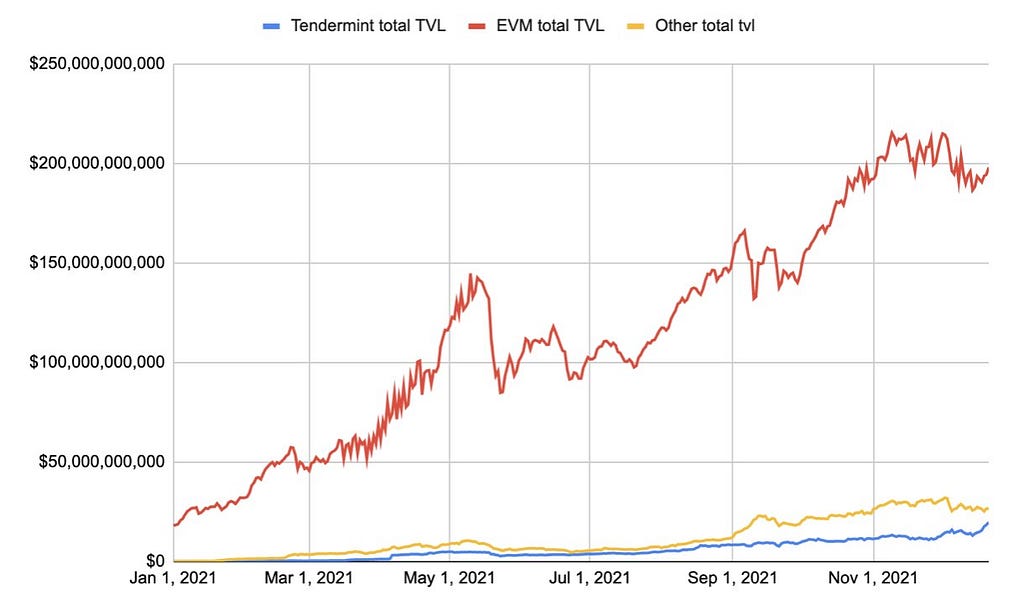
Remember that the EVM is essentially the brain of Ethereum that performs computations for the network. When other Layer 1s adopt the EVM, it makes deploying existing applications on new networks easier for developers, in addition to making it easier for users to migrate to these new chains.
The dominance of value on EVM compatible chains (Avalanche, Polygon, etc) suggest that a standard is forming around the EVM. This should ultimately keep Ethereum as the gravitational center of the smart contracting world, as ETH applications and assets will be natively interoperable with most other chains.
Rise of the app chains
While EVM chains still dominate the landscape, the end of 2021 saw a rise in value on Tendermint chains. Recall that Tendermint is a standard popularized by Cosmos, that lets developers build application specific blockchains that are capable of interoperating with one another.
Building app-specific chains in the past came with significant opportunity cost, because they were cut off from most liquidity and users. With the growth of Tendermint chains like Osmosis (AMM), Umee (lending), and Stargaze (NFTs), that’s becoming less of an issue.
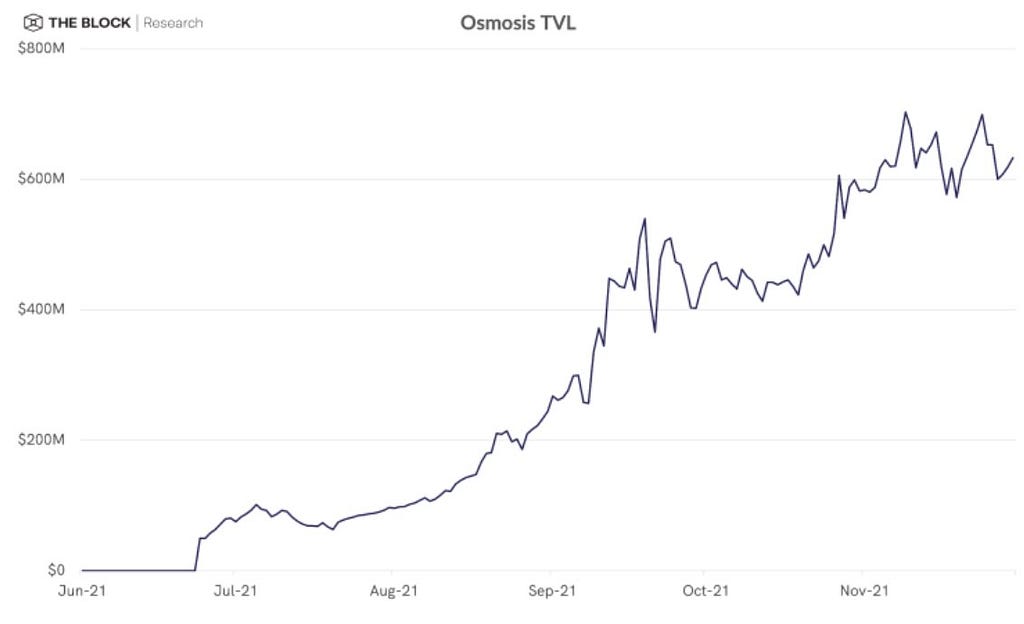
Now that these app specific chains have a widening array of use cases and liquidity that they can interoperate with, look for more builders to take advantage of customizability that these chains offer in 2022.
The ENS airdrop + DAOs
In 2021, ENS reminded everyone of Web3’s native user acquisition strategy: the airdrop.
ENS (Ethereum Name Service) addresses are best thought of as email addresses that you can send money to (e.g. Jimbo.eth). After 5 years in development, the project shifted to a DAO model, and airdropped ENS governance tokens to every user with an ENS address.
After the drop in November, awareness of ENS and registration of .eth addresses skyrocketed.

Since the ENS DAO treasury collects revenue from new .eth registrations, revenue for the newly minted ENS DAO treasury ramped up significantly: another testament to how much a well orchestrated airdrop can move the needle.
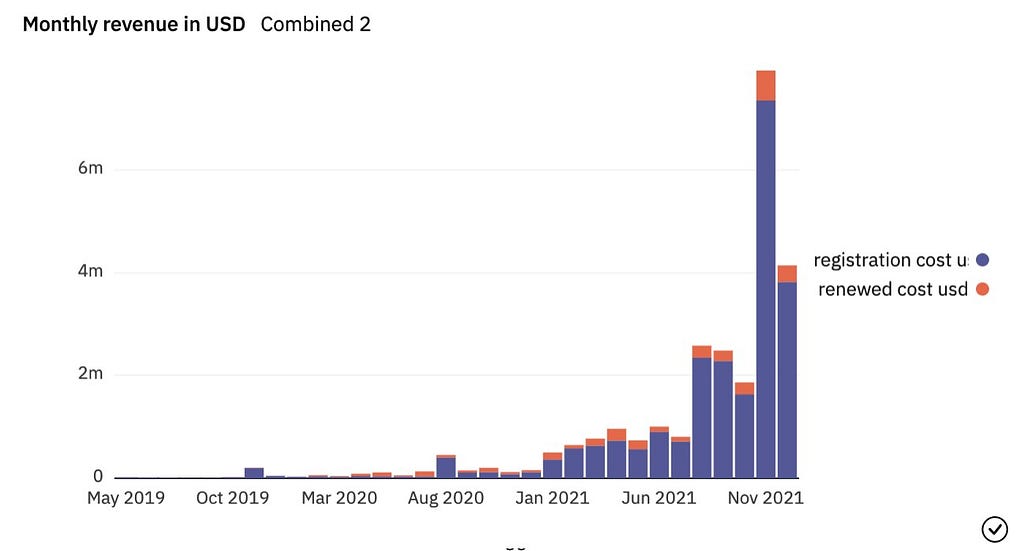
Beyond ENS, DAOs had a strong year, evident by the growing usage in key pieces of DAO infrastructure. Gnosis Safe, which is the most popular multisig wallet DAOs use to manage their treasuries, saw 3x growth in both the number of Safes and transactions executed in 2021. Snapshot, a tool that helps DAOs execute off-chain votes with on-chain verification, exhibited strong growth as well.
EN-EFF-TEES
Activity on the dominant platform for NFTs tells you all you need to know about the breakout year NFTs enjoyed.
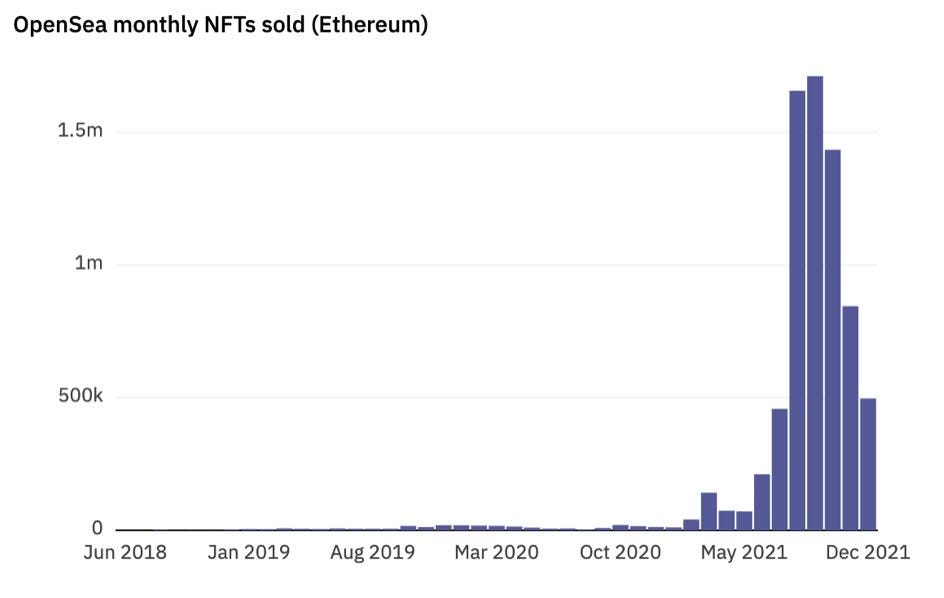
OG NFT CryptoPunks saw 60x YoY growth, reaching a total volume of 650K ETH, or $1.7B at current prices. This figure however, includes a flashloan powered $500M wash sale — a powerful reminder of how much subjectivity there is in on-chain data.
The second most notable NFT project of the year was Bored Ape Yacht Club, which went from a niche community to the celebrity NFT of choice, including the likes of Steph Curry, Shaq, Justin Bieber, Jimmy Fallon, Paris Hilton, among others. At one point the BAYC floor (price of the cheapest NFT in the collection) momentarily flipped the CryptoPunks floor.
In the heat of new issuances flooding the market, and older NFT collections achieving billion dollar market caps, the average price of NFTs changing hands did a 150x from 0.1 ETH to roughly 15 ETH by year end.
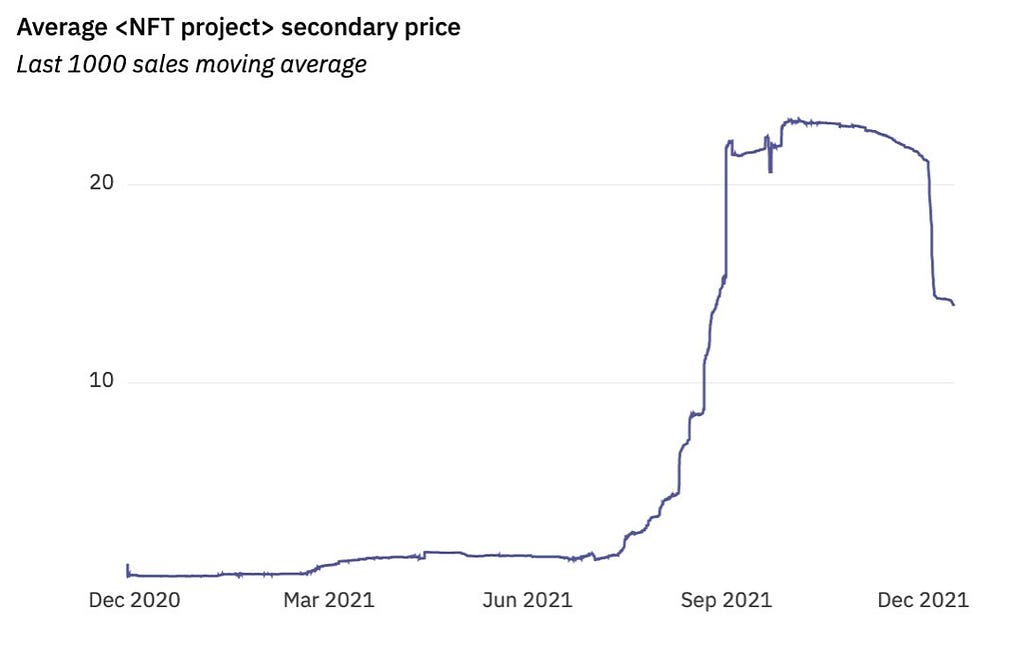
One of the most interesting NFT launches of the year was Loot (covered here), which let anyone mint 1 of 8,000 NFTs that could form the basis of a Dungeons and Dragon style RPG game. Initial excitement was skyhigh, before fizzling out as time went on.
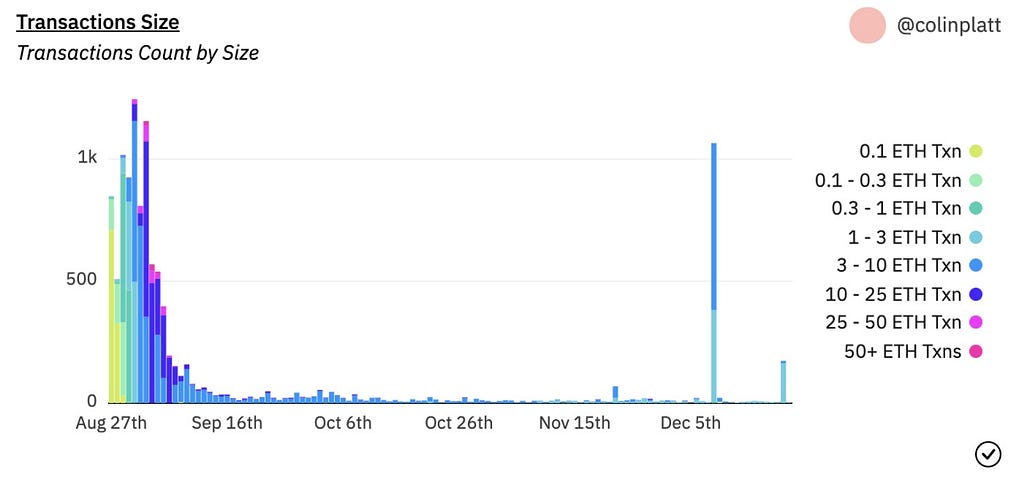
While Loot’s flame may have dimmed, it was still a landmark year for NFT based gaming, with the breakaway success of Axie Infinity bringing play-to-earn and GameFi narratives to the forefront. As the data shows, Axie Infinity NFT volume dwarfs that of any prior NFT based game.
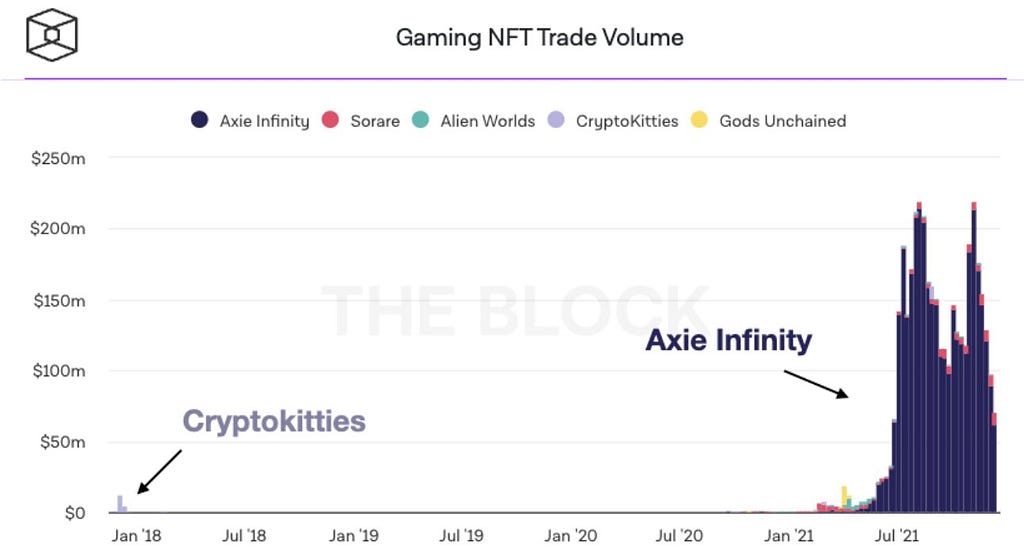
Lastly, while Ethereum was the center of the NFT show, marketplaces appear to be springing up across multiple chains. The data shows that lower fee environments are enabling different types of user activity. Solana’s Magic Eden, for example, has more transactions than OpenSea since users are unencumbered by exorbitant gas fees.
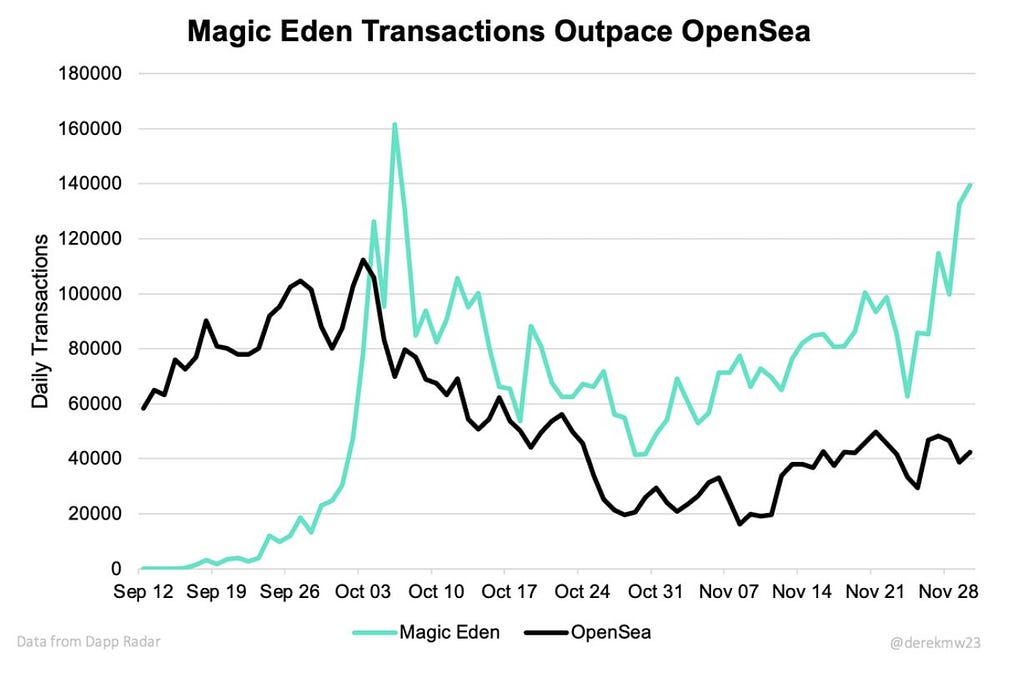
More in Elias’s epic thread
Beyond being chock-full of illuminating data points on the year in crypto and Web3, the full thread underscores the beauty of on-chain data and the increased maturity of the industry. The ability for one person to put together a dataset this rich is a testament to all of the great data providers the industry now has at our disposal.
If you haven’t already, check out the full thread which covers Bitcoin, Ethereum, MEV, L2 adoption, ETH2, staking, Web3, memecoins, DEXes, stablecoins, and a whole lot more.
~Written by Connor Dempsey & Justin Mart.
This website does not disclose material nonpublic information pertaining to Coinbase or Coinbase Venture’s portfolio companies.
Disclaimer: The opinions expressed on this website are those of the authors who may be associated persons of Coinbase, Inc., or its affiliates (“Coinbase”) and who do not represent the views, opinions and positions of Coinbase. Information is provided for general educational purposes only and is not intended to constitute investment or other advice on financial products. Coinbase makes no representations as to the accuracy, completeness, timeliness, suitability, or validity of any information on this website and will not be liable for any errors, omissions, or delays in this information or any losses, injuries, or damages arising from its display or use. Unless otherwise noted, all images provided herein are the property of Coinbase. This website contains links to third-party websites or other content for information purposes only. Third-party websites are not under the control of Coinbase, and Coinbase is not responsible for their contents. The inclusion of any link does not imply endorsement, approval or recommendation by Coinbase of the site or any association with its operators.
Crypto’s 69 most interesting charts from 2021 was originally published in The Coinbase Blog on Medium, where people are continuing the conversation by highlighting and responding to this story.
2 February 2022 05:20